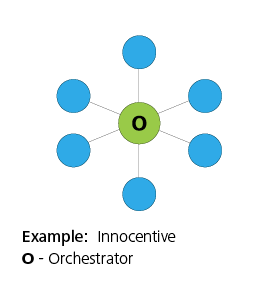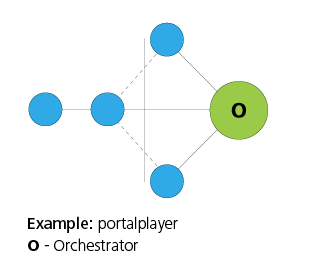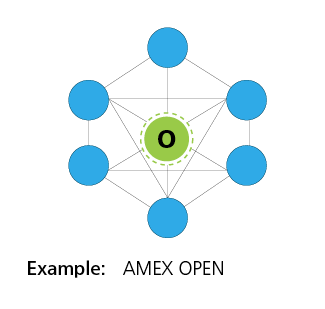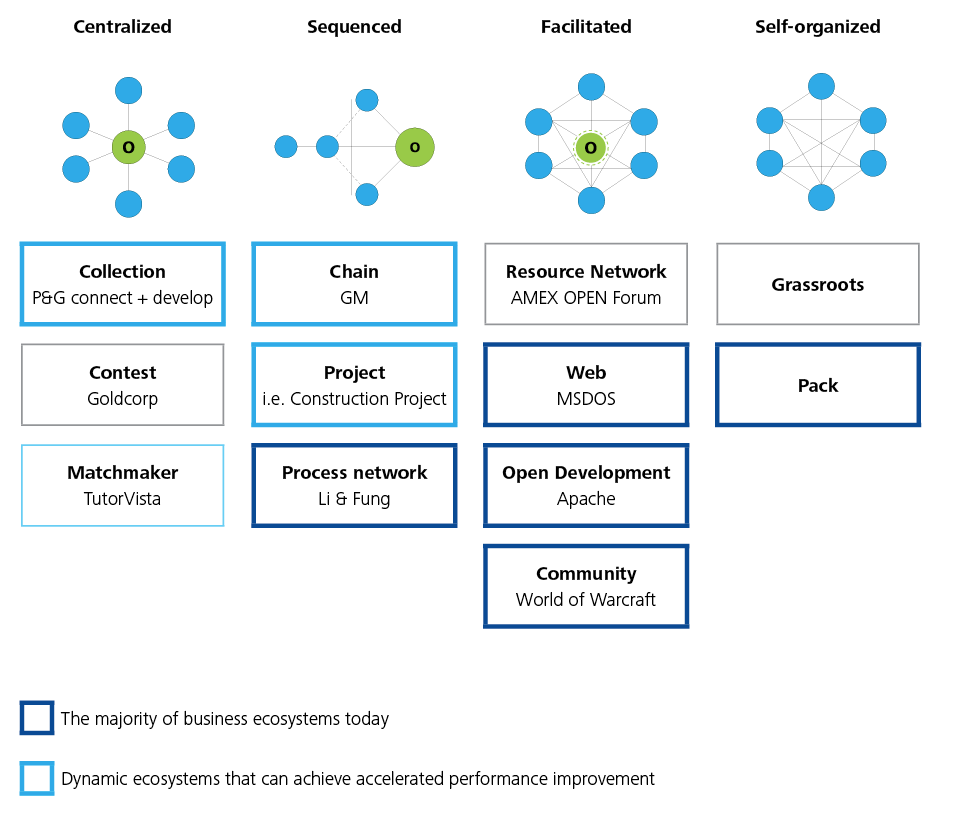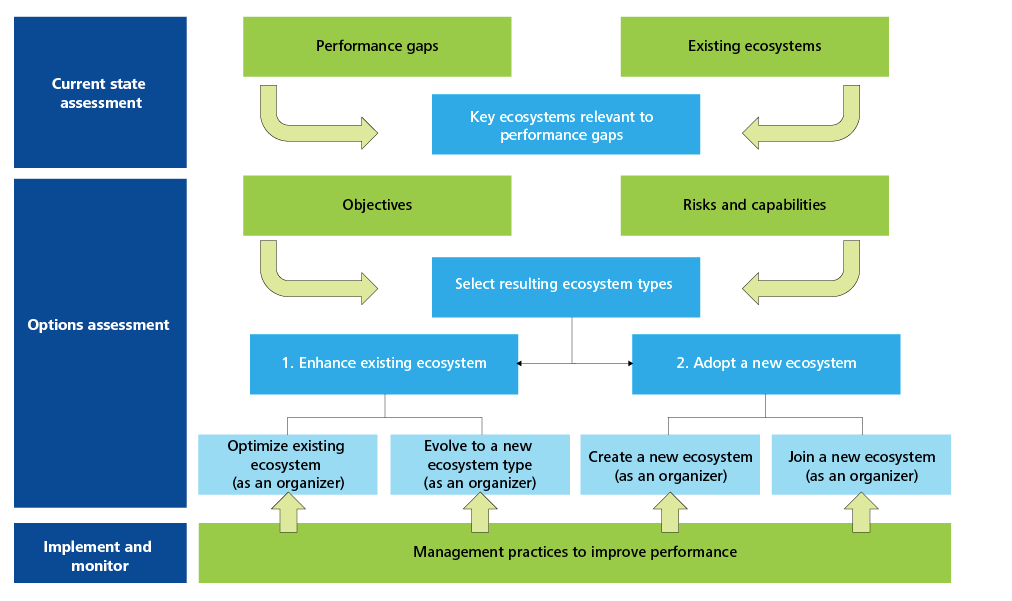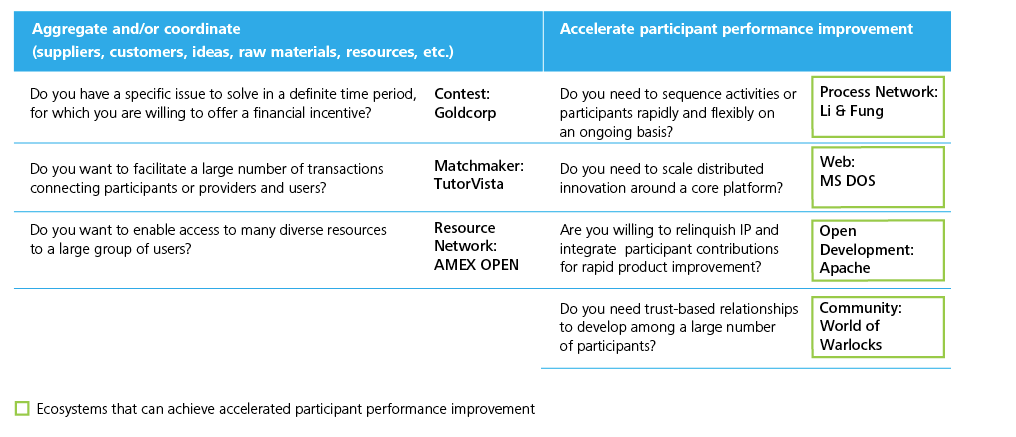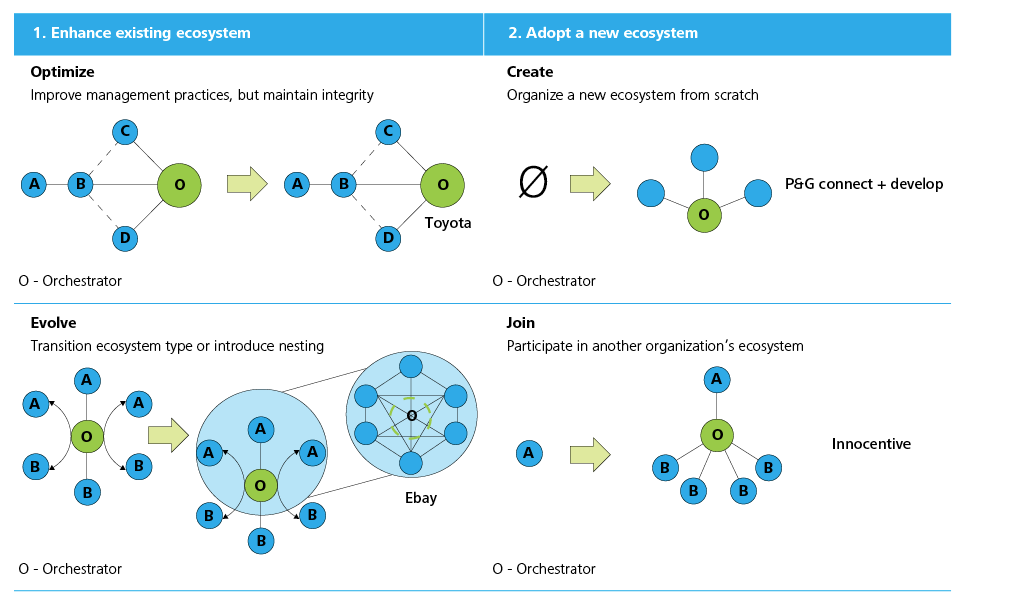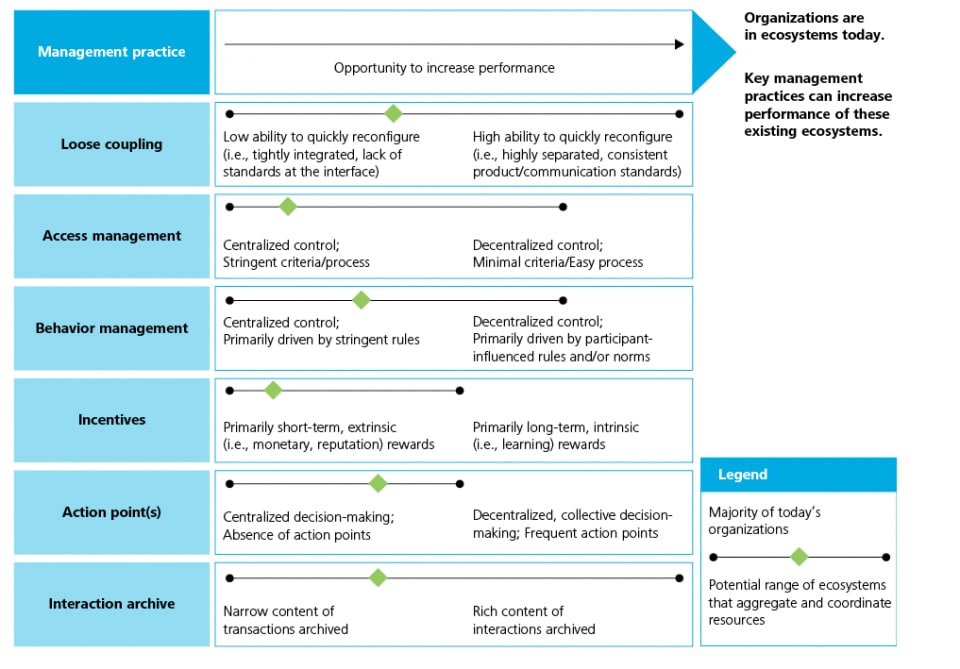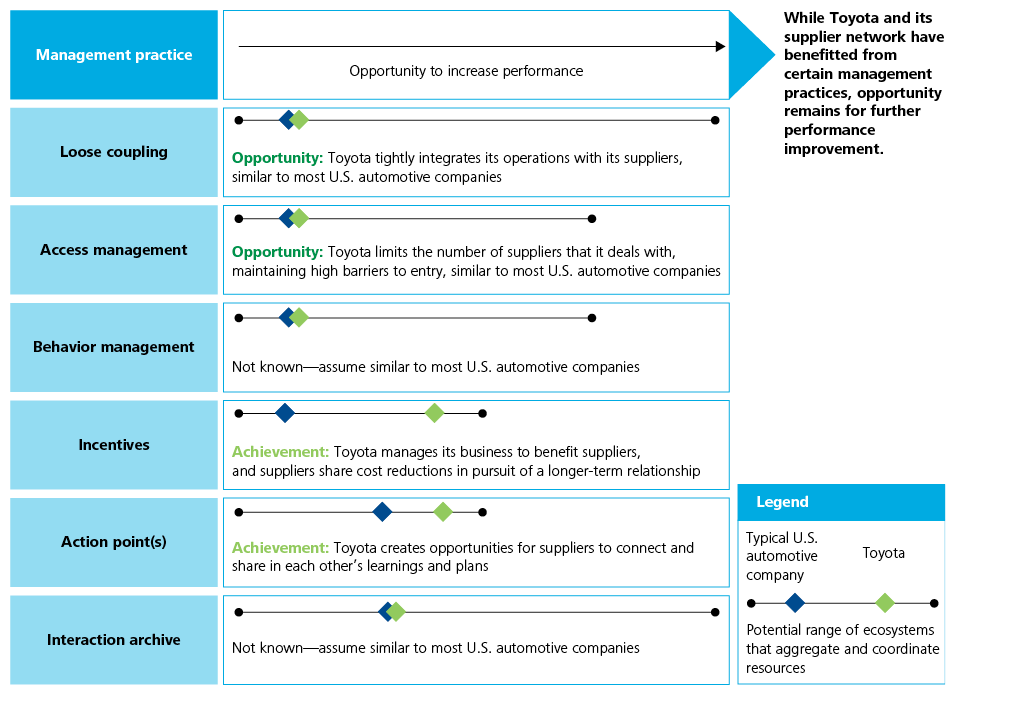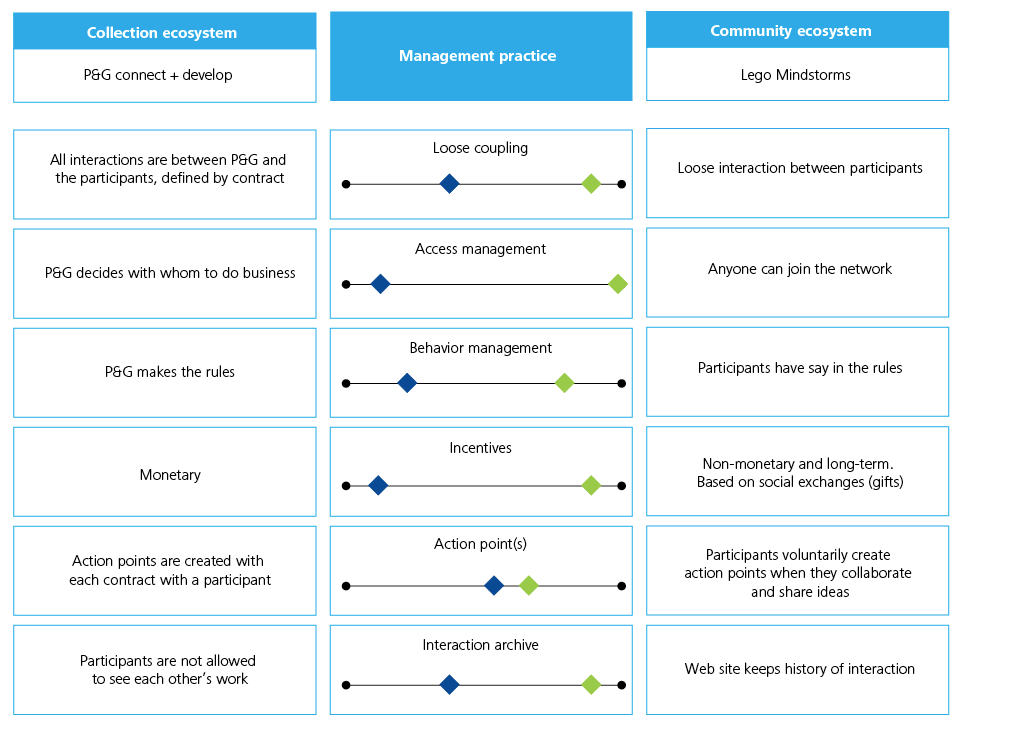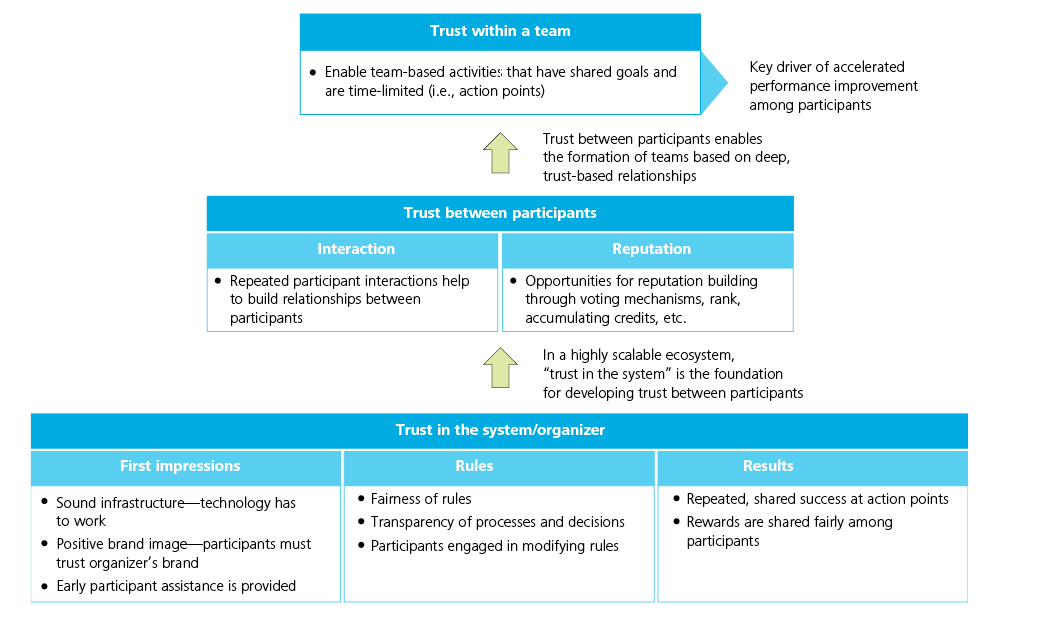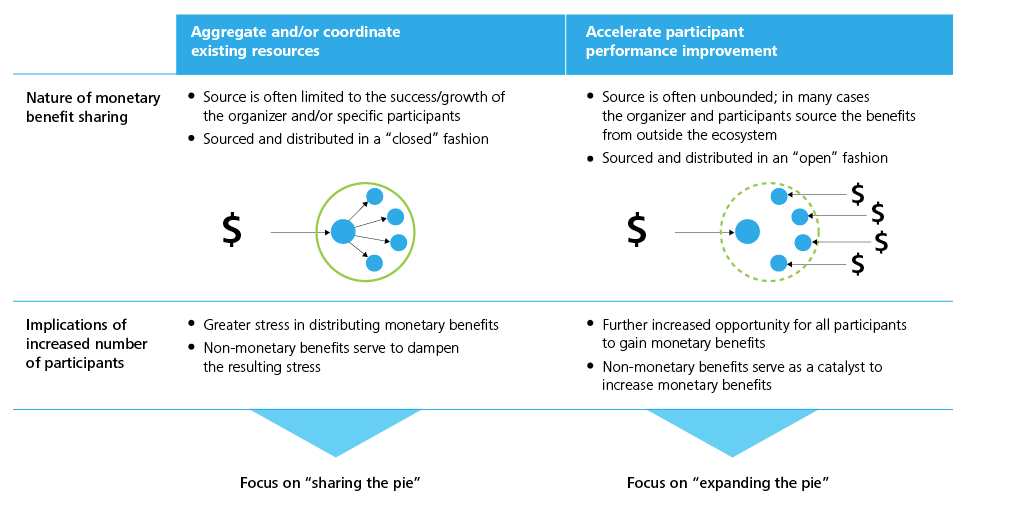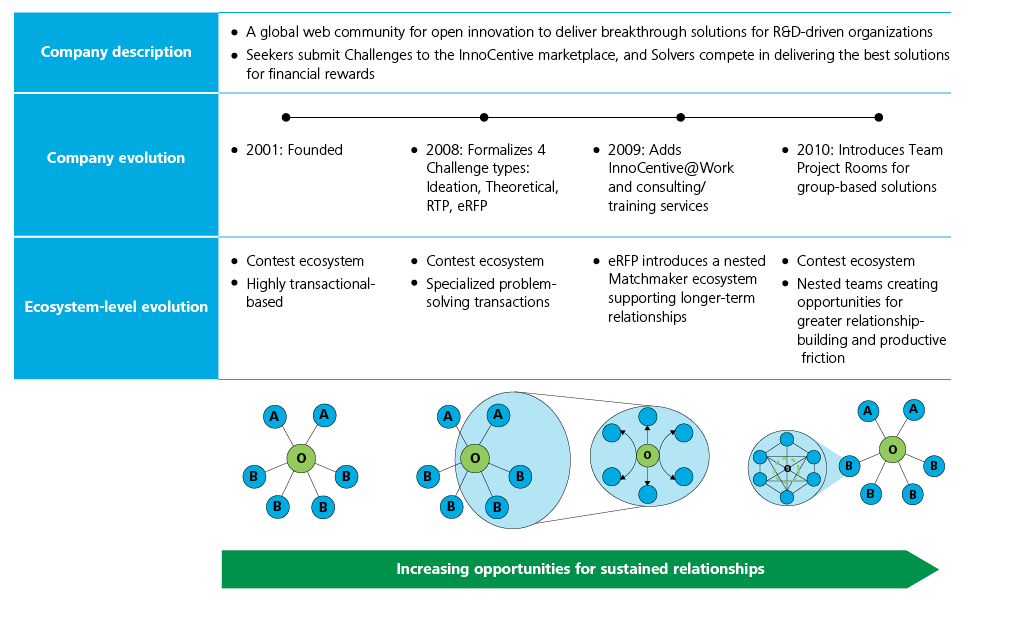Performance Ecosystems has been saved

Performance Ecosystems A decision framework to take performance to the next level
02 January 2012
No company is an island—each operates within ecosystems. Yet most companies lack a robust decision framework to choose those ecosystems and understand the implications of their choice. This report defines ecosystems and assesses the value ecosystems create, as well as the social software and other technology that can be used to manage and deploy them. What are the potential risks associated with different types of ecosystems, and how might those risks be mitigated?
Introduction—Ecosystems defined
In the quest for growth, cost reduction, or innovation, today’s business leaders often realize that it is increasingly difficult to “go it alone.” The growing need to connect to talent, wherever it resides, has significantly changed the path to success, moving it outside the four walls of the company and into a broader array of performance ecosystems.
The word “ecosystem” is one of the most overused terms in the business lexicon today, resulting in confusion and inconsistency in usage. To address the confusion, this paper takes this broad topic and narrows it down into specific choices available to business executives. To start with, we use the following definition:
A performance ecosystem consists of multiple (three or more) independent organizations and/or individuals interacting with one another to pursue shared goals.
Three important assumptions help to further differentiate this definition:
- The goal of an ecosystem is to improve some form of performance
- Ecosystems can consist of both organizations and individuals
- Ecosystems do not need to be limited to one specific purpose (e.g., innovation)
This paper offers a clearly defined taxonomy that provides options and guidance to executives around the available opportunities and how they can use ecosystems to support their business objectives.
How did a group of obscure motorcycle assemblers in China challenge the best corporate giants of Japan?
The answer lies in their ability to tap into a high-performing ecosystem.
Breaking out of today’s limited ecosystems
 While the discussion of ecosystems may be a recent phenomenon, ecosystems are nothing new at all. Every business is involved in many different ecosystems, alongside its suppliers and customers. Organizations today operate in only a few limited ecosystem types, primarily with the focus of aggregating and coordinating existing resources. However, these “static” ecosystems do not drive the greatest value. The greatest value comes from tapping into ecosystems where all participants in the ecosystem get better faster by working together across enterprises—what we refer to as accelerated participant performance improvement. While traditional forms of aggregating and coordinating ecosystems should not be ignored, dynamic ecosystems that drive accelerated performance improvement are becoming more and more central to value creation, presenting new opportunities for executives.
While the discussion of ecosystems may be a recent phenomenon, ecosystems are nothing new at all. Every business is involved in many different ecosystems, alongside its suppliers and customers. Organizations today operate in only a few limited ecosystem types, primarily with the focus of aggregating and coordinating existing resources. However, these “static” ecosystems do not drive the greatest value. The greatest value comes from tapping into ecosystems where all participants in the ecosystem get better faster by working together across enterprises—what we refer to as accelerated participant performance improvement. While traditional forms of aggregating and coordinating ecosystems should not be ignored, dynamic ecosystems that drive accelerated performance improvement are becoming more and more central to value creation, presenting new opportunities for executives.
These dynamic ecosystems do not need to be built “from scratch” in order to achieve performance goals. Evolving from an existing static ecosystem to a dynamic ecosystem may present a significant untapped opportunity to achieve accelerated participant performance improvement. Many companies will likely need to extensively transform their existing business ecosystems to maximize value; however, they may be able to make the necessary changes by pursuing a pragmatic migration path.
While there are inherent risks and tradeoffs in pursuing an ecosystem strategy, executives tend to emphasize the wrong forms of risk. Many executives shy away from fully participating in ecosystems due to fears of losing control of intellectual property or being tainted by one bad apple in the group. These risks are real, but they can be mitigated by carefully choosing the appropriate ecosystem to pursue, understanding the management implications of these choices, and then slowly and systematically evolving the ecosystem. Furthermore, these risks can be outweighed by the benefits obtained from dynamic ecosystems. Perhaps the greater risk is not being able to participate in the rapid performance improvement that can best be achieved within dynamic ecosystems. In a world of mounting performance pressure, companies that do not fully tap into the potential of dynamic ecosystems are likely to be increasingly sidelined in global markets.
Ecosystems taxonomy—Helping to make sense of the choices
Based on research covering more than 50 case studies, ecosystems can be grouped under four broad categories: Centralized, Sequenced, Facilitated, and Self-Organized. These categories emerge from observable characteristics of the ecosystem such as basic structure, presence or absence of a central organizer, and the connections between participants.
A few caveats are warranted. First, ecosystems are often evolving; thus, the categorization of any ecosystem is based on a snapshot at a certain point in time. Second, ecosystems are often “nested” within other ecosystems; categorization starts with the highest possible level, after which nested levels can be identified as well. Lastly, the types are not differentiated by business objective; a single ecosystem type might be applicable for many different business situations.
Centralized ecosystems
Centralized ecosystems have a clear organizer, who may not control the way participants work individually, but drives the interactions required to achieve the ecosystem’s objectives. Participants generally do not interact with each other, only with the organizer.
An example is the core ecosystem developed by InnoCentive, which a growing number of companies use to supplement internal R&D efforts.1 With InnoCentive, companies post difficult problems, which can then be solved by a field of innovators, experts, and creative thinkers. InnoCentive is evolving to foster more team interaction, but it was originally set up in such a way that all the participants were independent and engaged in short-term transactions facilitated by InnoCentive, as cited by Karim R. Lakhani in his business case on InnoCentive for the Harvard Business Review.
There are three distinct types of centralized ecosystems:
- Collection ecosystems gather or distribute information in a typical hub-and-spoke manner. An iconic example is Procter & Gamble’s “Connect and Develop” program, which supplements internal R&D efforts by extensively scanning for external ideas.2 Once these ideas come in, P&G utilizes internal resources to develop them, without any additional external input.
- Contest ecosystems invite companies or individuals to solve a problem. As mentioned previously, InnoCentive is an example of a contest ecosystem. Another example would be the Goldcorp Challenge, where mining company Goldcorp released massive geological data to outsiders and invited participants to enter a contest identifying the best excavation sites at an Ontario mine.
- Matchmaker ecosystems, like the name suggests, connect participants to fulfill a purpose. An example is TutorVista, an on-line service that connects students located anywhere in the world with tutors in India for virtual tutoring sessions.3 Once a student and tutor are matched, the two communicate directly, but always via the TutorVista website.
Sequenced ecosystems
Sequenced ecosystems are most commonly represented today by a traditional supply chain. These include a series of activities that must be coordinated in a sequential fashion by a central organizer. We have further classified this category into three distinct types:
- Chain ecosystems have a central organizer who coordinates activities on an ongoing basis, typically specifying with a high level of detail the activities that must be performed in a tightly integrated fashion. Participants may interact with additional upstream or downstream participants. Any supply or distribution chain, such as General Motors, is a good example of a chain ecosystem.
- Project ecosystems are structured to execute complex transactions within a specific time period with a defined end-result. Basic construction projects are an example of this type of ecosystem.
- Process network ecosystems support extended end-to-end business processes involving many participants in a modular, loosely coupled management approach. Rather than specifying individual activities in great detail, the central orchestrator of these ecosystems focuses on defining modules of activities to be performed by individual participants and ensures that the interfaces across these modules conform to mutually agreed standards so that one participant can be brought in or swapped out quickly, depending upon changing needs or circumstances. Chinese company Li & Fung, which operates a global network of more than 10,000 business partners in the apparel industry, provides an interesting example of this type of ecosystem.4 Li & Fung configures customized supply networks for apparel designers, identifying the appropriate participants from its vast network, assigning them specific modules of activity, and then coordinating to make sure that performance standards are met at each hand-off from sourcing of raw materials to ultimate delivery of the finished goods to specific retail distribution centers.
Facilitated ecosystems
Facilitated ecosystems have mesh-like connections, with complex patterns of interactions evolving among participants. While behavior is primarily participant-driven, an orchestrator gently shapes the interactions through governance and interaction protocols. American Express Open Forum for small business owners is an example of a facilitated ecosystem.5 This is an online forum for AMEX cardholders where small business owners can interact, ask questions, offer advice to each other, and tout their wares or services. There are four main types of facilitated ecosystems:
- Resource network ecosystems are formed when an organizer wishes to facilitate access to many diverse resources for a large number of people, such as American Express Open Forum.
- Web ecosystems emerge when organizers want to scale distributed innovation around a core platform and participants are attracted to adopt the platform and develop products or services on top of it, driven by incentives of market success. Microsoft DOS is the classic web ecosystem example. Microsoft developed the operating system platform and promoted it to attract a vast ecosystem of participants. Anyone who wanted to could license the operating system, and in most cases Microsoft had no direct contact with individual members of the ecosystem. Yet, the entire ecosystem benefited from the distributed innovation that flourished on this platform as it became a de facto standard.6
- Open development ecosystems are formed when participants join together with the goal of jointly developing and evolving a product, inviting open participation from anyone who wants to join. While everyone is invited to contribute, governance protocols determine whose contributions will actually be integrated into each new release of the product. Open source software development initiatives are classic examples of this type of ecosystem. The Apache Foundation and all its contributors provide one example of an open development ecosystem.7
- Community ecosystems are formed when an organizer wishes to develop and scale trust-based relationships among a large number of participants. These ecosystems are defined by sustained and frequent interactions that accumulate over time and weave together all the participants to the point that they begin to identify themselves with the community. These ecosystems range from loosely defined Communities of Interest like discussion forums for music lovers or sports fans to more action-oriented Communities of Practice like the tightly knit guilds within World of Warcraft.8

Self-organized ecosystems
Self-organized ecosystems are purely participant-driven, with numerous routes of interconnectivity between participants who all come together in pursuit of a common objective. Extreme sports like big wave surfing on a global scale provide examples of self-organized ecosystems, embracing large numbers of participants with no central organizing body.
- Grassroots ecosystems are short-lived ecosystems with no defined standards, forums, barriers to entry, or rules for participation. They come together for a specific purpose, and then dissipate. An example is users of Stressed Skin Panels in the construction industry.9 These panels are used to construct building walls but require adaptation for a variety of uses. As individual contractors experimented and found the best techniques for altering the panels, these contractors shared ideas in informal ways, by word-of-mouth and via industry publications or bulletin boards. Eventually, many of these innovations were adopted by the panel manufacturers. Ultimately, the ecosystem dissolved as the product became more mature and well-defined in all of its variants, and since there was no longer a need for the ecosystem, it disbanded.
- Pack ecosystems include loosely organized participants who join an ecosystem with a specific “big picture” objective in mind for ongoing, sustained activity. With big wave surfing, the ecosystem developed as surfers came together on a global scale to share new surfboard designs and surfing techniques to improve performance and address more and more challenging waves.4
Dynamic ecosystems
Most ecosystems today focus on aggregating and coordinating something, be it suppliers, customers, or ideas. The introduction of newer technologies and the rapid evolution of the Internet have helped to create a wider range of ecosystem options, presenting a significant opportunity for accelerating participant performance improvement—whereby all participants get better faster by working together on a larger and larger scale. As shown in Figure 1, only specific ecosystem types have the potential to accelerate participant performance improvement: process network, web, open development, community, and pack. These ecosystem types are highly scalable and enable a high degree of interaction among participants. In addition, they have the potential to foster deeper trust-based relationships, and/or create the incentives necessary to attract a wide and diverse group of participants. Companies now have increasing opportunities to evolve from more traditional static ecosystems toward higher-performance dynamic ecosystems.
Figure 1: Ecosystem taxonomy
Thanks for the taxonomy—but where do I go from here?
Using key management practices and evolving to higher-performing ecosystem types can create greater value for organizations, but what approach can an organization use to select the right ecosystem? Figure 2 demonstrates three key steps to address the question:
#1. Assessing your current capabilities and existing ecosystems
The starting point should be an assessment of the current state of the organization, where key questions include:
- What are the existing capabilities, culture, and risk appetite of the organization?
- What ecosystems is the organization involved in today?
- Are these the appropriate ecosystems to meet performance objectives?
In our experience, the first question, where do I go from here?, is often the hardest for executives to answer—primarily because “ecosystems” are seen as a silver bullet, but the basic building blocks to participate in those ecosystems are absent from within the organization. For example, it may be advantageous for technology firms to operate within an open development ecosystem but the way that their talent competes within organizational silos and is motivated to perform may make them constantly default back to a project ecosystem.
Figure 2: A practical approach to selecting ecosystems hinges on defined business objectives
#2. Assessing your ecosystem options going forward
In assessing an organization’s options, two key questions include:
- Which ecosystem type(s) should be selected?
- Should the organization create, enhance, or join an ecosystem?
Once the ideal ecosystem type has been identified, how do you get there from here? In general, you can choose to either enhance your existing ecosystem, or participate in a new one.
In enhancing an existing ecosystem, there are two options:
- Optimize: Maintain the integrity of the ecosystem type; however, improve the management practices within. For example, Toyota has continued to operate a chain ecosystem with its suppliers, but has created tremendous value through the trust it has developed with its suppliers.
- Evolve: Change from one ecosystem type to another (e.g., chain to process network), or “nest” new ecosystems within an existing one. Nesting is when an ecosystem becomes fully contained within another higher-level ecosystem, often resulting in layers of ecosystems. For example, within the broader matchmaker ecosystem of eBay (with its matching of buyers and sellers), eBay has created various online merchant networks, where its merchants can connect with each other in a community-like fashion to share learning and best practices.11
Selection of ecosystem type ties directly to the organization’s objective. Figure 3 serves as a tool to guide the selection process. At the highest level, our ecosystem types fall into two buckets—those that are focused on aggregation and coordination, and those that are focused on accelerating performance improvement of all the participants involved, or helping everyone to get better faster. Beyond this broader categorization, specific questions help to answer which ecosystem type is most suited for the organization’s objective.
In choosing to participate in an entirely new ecosystem, there are two options:
- Create: Organize an ecosystem from scratch. P&G did this with its Connect and Develop program and connected with a whole new set of industry participants.2
- Join: Participate in someone else’s existing ecosystem to extract value from it. For example, a company can participate as a “seeker” in InnoCentive’s network, to obtain the best solution among numerous solvers.1
Figure 3: An organization's objectives guide the selection of the resulting ecosystem subtypes
Value can be created from any of these four options; however, the biggest “bang-for-your-buck” generally comes from evolution, especially from a static ecosystem to a dynamic ecosystem. This option usually creates greater value than “optimizing” or “joining”, while not requiring a company to start from scratch and make significant investments as would be required in the “create” option. With companies already heavily invested in their existing static ecosystems, evolution to higher-performing dynamic ecosystem types can expand the opportunity for value creation.
#3. Using key management practices to continually improve your ecosystems
Most companies today are generally not maximizing their ecosystem performance through existing management practices.
Executives have the opportunity to increase ecosystem performance by understanding the key management practices relevant to effectively designing and managing ecosystems. In other words, there is generally an opportunity to increase value simply by refining management practices within an existing ecosystem type.
These management practices are:
- Loose coupling: Enabling participants to be easily reconfigured to meet changing demands, resulting in greater flexibility and scalability
- Access management: Expanding the number of participants that can join, given the appropriate scope and objective of the ecosystem
- Behavior management: Enhancing the potential for effective interactions through behavioral norms, enforced rules, and participant performance feedback loops
- Incentives: Using the right combination of extrinsic- and intrinsic-based incentives (including reputation and intellectual challenge) to foster cumulative learning and capability building
- Action points: Embedding integration or decision milestones in which differences need to be resolved and agreement reached on the best approach for achieving a shared outcome—incorporating multiple action points creates opportunities for productive friction—it sharpens and forces choices
- Interaction archive: Recording rich content regarding participant interactions as a by-product of their actions, enabling a longer-term view toward the ecosystem’s opportunities
Figure 4: Evolving an ecosystem can create tremendous value without having to "start from scratch"
As illustrated in Figure 5, from our reading and interviews we found that most companies tend to cluster on the left side of each range, and are not taking full advantage of the value that can be achieved through each management practice. For example, ecosystems are often tightly coupled with respect to their supply chains, meaning that they are tightly integrated and have a low ability to adapt to meet changing demands. Increased value could be achieved by adopting greater loose coupling and modularity, allowing participants to quickly reconfigure when required.
Figure 5: An opportunity exists to increase performance in existing ecosystems by understanding key management practices
Vignette #1: Performance improvement at Toyota
Toyota provides an example of a chain ecosystem in its supply chain operations, (see Figure 6). It has been able to increase performance by “moving the needle” on some of the key management practices. Especially in the areas of behavior management, incentives, and action points, Toyota’s management of its supplier network has led to higher performance of the ecosystem as a whole.
Incentives: Toyota manages its business to benefit suppliers, and also allows suppliers to determine what percentage of their cost savings goes to Toyota.10 This drives longer-term incentives for both Toyota and their suppliers, helps strengthen relationships, and helps ensure that the quest for short-term gains does not undermine the potential for long-term benefits.
Figure 6: Case study - Performance improvement at Toyota
Action points: Toyota defines aggressive performance objectives and creates explicit milestones to focus the efforts of its partners on finding creative ways to meet these objectives.10 These action points drive active learning within the supply chain.
Vignette #2: Management practices matter -– A contrast of ecosystems
In practice, the design of ecosystems can dramatically vary based on the choices made across the key management practices. Figure 7 demonstrates how management practices differ between the cases of P&G Connect and Develop2 (a collection ecosystem) and Lego Mindstorms12 (a community), both focused on improving product development.
Figure 7: Management practices can vary considerably
Accelerating participant performance improvement
Examples such as Li & Fung (see below) bring to the forefront a very different model of ecosystems, enabling a second level of performance improvement in which significantly greater value can be created.
Li & Fung, a Chinese company in the apparel industry, oversees facilitation and coordination of a global network of more than 10,000 business partners, selecting the most appropriate participants in configuring customized supply networks for its customers.4
Rather than suing a user who reverse-engineered and published the software behind the Lego Mindstorms product, Lego “opened up” its system to the public and harnessed its customer base in designing future product improvements.12
Dusty and his friends became some of the most accomplished big wave surfers, through learning and critiquing one another as a tight-knit team, and interacting with surfers across the world to master their techniques.4
Beyond strictly aggregating and coordinating existing resources, what distinguishes these ecosystems is that they are highly scalable and can accommodate an extremely high degree of participant interaction. As a result, these ecosystems can accelerate participant learning and/or performance improvement over time, enabling all participants to get better faster as more participants join the ecosystem.
Key characteristics of accelerated participant performance improvement
Ecosystems benefit from network effects. These network effects are generally limited if there is minimal interaction among participants, as in highly centralized (hub-and-spoke) structures. Because of the minimal interaction of the participants, each additional participant just increases the value of the ecosystem by “one”—that participant. As interaction increases among participants, stronger network effects can be achieved even though participant capabilities remain stable or unchanged over time. As an analogy, think of a network of fax machines. One fax machine by itself is useless—it actually has negative value. It costs money to buy but cannot be used for anything. As more fax machines are added to a network, the value of each fax machine increases. The value of the network increases exponentially as more and more fax machines are added, yet the functionality of each fax machine remains static.
Now let’s say each fax machine improves and builds its capabilities over time and that its rate of improvement accelerates with the addition of each new fax machine—this is what we mean by accelerated participant performance improvement. In this case, we get a second order of increasing returns, amplifying the basic network effects that occur with a simple increase of the number of participants. This second order of increasing returns comes from the opportunity in some ecosystems to develop complex meshes of interactions with all the other participants in ways that help accelerate the learning and performance improvement of each participant. In ecosystems that foster long-term, trust-based relationships among participants, there is more incentive to work together to learn from each other. The increasing diversity of participants tackling specific performance improvement initiatives can generate more creative solutions, further amplifying the learning opportunity.
Companies have an opportunity to evolve their existing static ecosystems to these newer, higher-performing dynamic ecosystems. Figure 8 lists the unique characteristics that distinguish static ecosystems that simply aggregate and coordinate existing resources from dynamic ecosystems that accelerate participant performance improvement.
Rapidly scaling dynamic ecosystems that accelerate participant performance improvement pose a unique paradox: “How can you have a highly scalable ecosystem and still maintain deep, trust-based relationships among participants?”
These dynamic ecosystems typically resolve the paradox by providing rich environments for both individual-based interactions and team-based interactions. While individual teams cannot scale beyond a certain size without eroding the trust-based relationships that sustain team performance, the ecosystem overall can scale by accommodating more and more teams. These teams are not just self-contained entities—members of the teams usually interact in a broader network that fosters learning and performance improvement across teams. By bringing together diverse participants within individual teams, fostering trust-based relationships, and focusing these teams on challenging performance improvement initiatives, these ecosystems can encourage productive friction at the individual team level, which in turn can lead to major new advances in performance. Much of this learning can then get further disseminated as team members engage with members of other teams in broader discussion forums and problem-solving venues.
Figure 8: Evolution presents a significant opportunity to achieve accelerated participant performance improvement
Trust building in ecosystems
Trust within teams is not something that just builds by chance in ecosystems; instead, key practices encourage trust-building. The starting point is an individual’s trust in the ecosystem (or organizer), which in turn provides an environment for deeper trust- building within teams.
Trust in the ecosystem can be nurtured from the time an individual begins to participate in the ecosystem; therefore, first impressions (including the organizer’s brand) can be critical to trust development. At this level, the rules of the ecosystem also influence the ability to build trust. Most successful ecosystems have minimally restrictive rules, providing an opportunity for participants to evolve their own norms and rules and to develop a sense of “ownership” of the ecosystem. Where rules are required, fairness, transparency, and buy-in of participants help to build trust.
Trust among participants becomes more significant over time, as a participant’s involvement in the ecosystem leads to greater interaction with others. Here, creating opportunities for broader participant interaction is crucial. Mechanisms to build reputation among participants can help participants to find each other and to develop trust more rapidly based on demonstrated performance in the past. For example, many online communities have reputation systems that allow participants to rate the quality and quantity of other participant contributions.
Trust within teams helps to foster even deeper levels of trust within smaller groups of participants over time. Providing the functionality for participants to form their own “teams,” “groups,” or “rooms” and engage in sustained interactions to address performance challenges will help enable concentrated team-based interactions. This can be further enhanced by tools to record objectives, milestones, and group interactions; share documents; and conduct other necessary tasks for group creation and interaction.
Sharing of economic benefits
Because of the learning and performance improvement resulting from these trust-based relationships, these dynamic ecosystems tend to have an advantage when it comes to sharing economic benefits, or profits, among participants.
In static ecosystems that aggregate and coordinate existing resources, the rewards that can be distributed to participants by the organizer tend to be more limited. As a result, disputes can arise over how to more “fairly” distribute these limited rewards. A “win/lose” mindset can often develop—if one participant gains more rewards, it means the rewards for the rest become even more limited. This perception can erode trust and increase competition at the expense of collaboration. For example, in a contest ecosystem, there is a limited pool of “prize” money awarded to the winner, and the losers get nothing. The greater the number of problem solvers, the less likely the opportunity to win. In a chain ecosystem, participants at each level in the chain are tempted to try to squeeze participants in other levels in order to keep more of the rewards for themselves.
In dynamic ecosystems that accelerate participant performance improvement, the focus shifts from “splitting the pie,” to “expanding the pie.” In this case, learning, performance improvement, and reputation building in the short-term offer the promise of expanding rewards for all in the longer term. While there will still be disputes over the allocation of the rewards, these tend to be significantly dampened by the growing awareness of the potential to participate in a rapidly expanding reward pool. For example, in open development ecosystems like open source software, participants are often motivated by the growing sense that they are deepening their skills and that their reputation as contributors of creative code will help to make them more marketable, leading to substantial monetary rewards at a personal level.
Figure 9: Key practices create system-level trust and an ecosystem scales, which in turn enables participant-level trust
Figure 10: Higher-performing ecosystems avoid the stresses associated with "sharing the pie" of economic benefits
Figure 11: Case study - Evolution of InnoCentive
Vignette #3: Evolution at InnoCentive
Over the last 10 years, InnoCentive has taken some major steps in advancing its services and offerings, including formalizing four distinct types of challenges in 2008, adding a consulting services arm in 2009, and most recently, introducing Team Project Rooms, where solvers can privately collaborate on their combined solution.13
These changes have had key implications for the evolution of InnoCentive’s underlying ecosystem (see Figure 11):
- 2001: Contest ecosystem with a number of independent, transactional challenges taking place over time.
- 2008: Established specialized types of transactions—eRFP in particular allows companies to request for a partner or supplier to provide materials or expertise, thereby introducing a nested matchmaker ecosystem with a subset of participants. This platform matches participants not only for a single transaction, but for ongoing business purposes(supporting longer-term relationship building within the network).
- 2010: Introduced Team Project Rooms to increase quality and quantity of solutions. This helped to encourage something that was already happening informally offline—groups of participants were coming together to jointly solve some of the problems posted. Now, InnoCentive more actively encourages teams to form and provides them with environments to engage in sustained and collaborative problem-solving.
While InnoCentive is still a contest ecosystem (hub-and-spoke structure) at the highest level, this case study demonstrates how an organization can begin accelerating participant performance improvement by evolving its static ecosystem through the nesting of dynamic ecosystem types.
Ecosystem risks and mitigation
While there are inherent risks and tradeoffs in adopting newer forms of ecosystems, executives tend to under-emphasize the considerable risks of remaining committed to lower-performing static ecosystems. In a world of intensifying competition and more rapid innovations, organizations in static ecosystems risk being left behind. Static ecosystems that simply aggregate and coordinate resources without focusing explicitly and aggressively on accelerated participant performance improvement typically only tap into a small portion of the potential value that can come from more dynamic ecosystems.
Risks from accelerated participant performance improvement
Disclosed IP: Sharing intellectual property (IP) has its risks, but these risks should be balanced against potential rewards. By releasing IP to a broader range of participants, companies can often stimulate more creative problem-solving and distributed innovation that exceeds the capability of individual companies. IBM provides an example of a company that has contributed significant amounts of IP to open development ecosystems, allowing it to focus on areas where it has a more distinct competitive advantage while motivating rapid enhancement of the contributed IP by third parties. Modular architectures can increase flexibility in deciding to contribute certain modules of IP to broader ecosystems while retaining other modules of IP inside the company. A staged approach to releasing IP can also help to manage risk. By beginning with less critical IP, a company can learn how to stimulate broader ecosystem development and accelerate enhancement of the IP before it decides to release more valuable IP.
Figure 12: Risks from existing ecosystems and accelerated participant performance improvement
Culture clash: A second risk is a culture clash between the employees of an organization who have the task of orchestrating broader ecosystems and the rest of the employees in the organization. Note that the culture of static ecosystems that aggregate and coordinate resources is not too different from most business cultures today. However, much different management styles are required to move to to higher-performing dynamic ecosystems. The potential for a culture clash can be mitigated by recruiting and developing “gateway” managers who have the ability to bridge across markedly different business cultures. Staged growth of ecosystems can also help managers to learn as they go, adapting to evolving ecosystem cultures as they observe what works and what does not.
Viral unfavorable opinions: In an increasingly competitive and unforgiving market, negative opinions are inevitable and a genuine risk, whether in an ecosystem the company organizes or in social media like third-party blogs and broader social networks. Encountering those negative opinions from customers or third parties in a company-organized ecosystem may be discomfiting; however, early visibility into the issues can help to mobilize resources to respond in a prompt and positive way. This is far better than having unfavorable opinions expressed in online forums that marketing scans may not detect, especially in early stages of discontent
Over-engineering: A fourth risk is more procedural. Being too prescriptive and comprehensive (i.e., over-engineering) in the early stages of building an ecosystem may block participants from interacting in ways that are more productive. Far better to begin simply with modest functionality and as few rules as possible and evolve the ecosystem by observing where and how participants engage. Seeding modest new initiatives, feeding the ones that engage participants the most, and weeding the ones that turn people off can be a far better approach than trying to anticipate every possible contingency at the outset.
Conclusion
In order to succeed in today’s fast-changing business world, harnessing the power of ecosystems is crtical. Businesses are already in ecosystems today—whether by design or not. Through a more systematic development of a set of ecosystem management practices and by evolving to higher-performing dynamic ecosystems, executives can accelerate participant performance improvement and generate greater value for the individual company and the ecosystem as a whole.
© 2021. See Terms of Use for more information.



